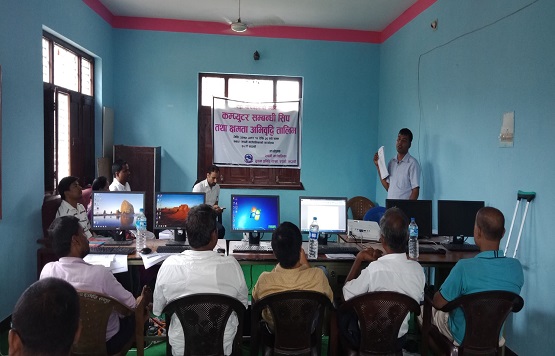समाचार
सूचना तथा संचार प्रविधि शाखा
History of IT and Computers in Nepal

The history of IT and computers in Nepal dates back to not more than a couple of decades. However, the growth of Information Technology here has been rapid. The major leap towards the advancement in this field started when the first computer IBM 1401, a second generation mainframe computer (image below), was used in the 1971 census, although an electronic calculator called ‘Facid’ was used before in the 1961 census. Again, another second generation mainframe computer ICL 2950/10 was used for the 1981 census.
The credit for introducing internet among the people mainly goes to the private sector. Although the internet was initially limited only to email services, in 1995, a company Mercantile Communications finally started the internet services in the country. In 1998, Nepal Telecommunications Authority (NTA), a telecommunications regulatory body, was formed as per the Telecommunications Act 1997. NTA holds the power to issue license to the Internet Service Providers (ISPs) in Nepal.
Some of the major licensed ISPs in Nepal are:
- Mercantile Communications Private Limited
- Worldlink Communications Private Limited
- Nepal Doorsanchar Company Limited
- Broadlink Network and Communications Private Limited
- Hotlink Nepal Private Limited
Analyzing the ICT development of Nepal
As we know Nepal is the country locked by the largest two countries India and China. The variation in the structure is also another geographical identification of Nepal. So Nepal was greatly influenced by the progress of the many countries in the region that had already welcomed the development of information technology (IT), particularly the two Asian superpowers, India and China. Nepal had witnessed India's ability to carve out a market in the IT sector, and was hoping to find a place in the field. Today Nepal is also aware to recognize the importance of the production and use of information and communication technology (ICT) for competitiveness and growth and the need to incorporate national information infrastructures to sustain and expand their economies. There is no question why we need to acquire IT in developing country like Nepal; however we need to know that what role IT can play in development process of these countries. The far reaching impacts of IT are not only limited to industrial production. All economic sectors including agriculture, banking, commerce, health care, education, publishing, transportation are become fast flexible. If properly used in the developing country, IT can be the main factor in increasing productivity in public administration, communications, infrastructures, industry and agriculture.
Stages of development of ICT in Nepal
1971 Introduction of computer in the country for census (IBM1401)
1974 Establishment of the Electronic Data Processing Center
1982 First Private Overseas Investment in software development by establishing company for export, Data Systems International (p) LTD.
1985 Distribution of Personal Computers in Nepal
1990 Liberalization on imports of equipment
1992 Establishment of Computer Association of Nepal
1996 Establishment of the Ministry of Science & Technology
1998 Telecommunications Act 1997 and Regulation
1998 Establishment of Nepal Telecoms Authority (NTA)
2000 Announcement of the first IT policy, “IT Policy 2000”
2001 Establishment of the National Information Technology Center(NITC) as ICT Implementation Body
2003 Establishment of the High Level Commission for Information Technology
2004 Telecommunication Policy 2004
2004 Electronic Transaction ordinance 2004
2006 Electronic Transaction Act Oct, 2006
2010 Announcement of IT Policy 2067
This is the overview of ICT development of Nepal. We have lot of experience for developing country toward the knowledge base society. Since the introduction of computer for census in 1972, the country made an early start compared to the other countries, including the establishment of organizations for computerization. However, in the 1980s and 1990s, Nepal slowed down its momentum to push forward the advancement of ICT industry. Starting from the 2000s, the government instituted its first ICT policy and in 2003 organized the HLCIT to take charge of national IT policies. In 2004, it promulgated the Electronics Transaction Act and now we have again the new review on IT policy 2000 and proposed the IT Policy 2067 as a measure of procedural simplification with a view to creating a hassle-free climate for the development of knowledge based Society and eliminate the poverty from Nepal.
We feel that this policy is a significant and important step in the right direction towards the developing the ICT sector and represent the society as knowledge based society. But however several challenges have beset Nepal’s efforts aimed at building upon the initial momentum that it gained in the ICT domain. Due to the lack of political constancy deterred Nepal from effectively capitalizing on the promise Unleashed by digital opportunities as the country found itself confronting a host of competing priorities ranging from the ones posed by security challenges to that of endemic poverty and poor governance. In the planning process, the government expressed its desire to meld Nepal into a knowledge-based society. The broad objective for the IT sector was to promote IT as a tool for social and economic development; to promote social development by using IT to improve agricultural, health, education, and other services and sectors; to promote economic development by establishing an IT park to produce and export low-cost software and eliminate the poverty from country which is the one of major problem for Nepal.
We have the experience of failure for completely implementing the Policy and over the last few years with scarce resources tied up in security efforts, implementation of the IT Policy has slipped from the government’s priority list. Although the institutional provisions have been put in place, the key implementing body is too under-resourced to effectively oversee implementation. We also know that e-governance in Nepal is enhancing but still not fully developed. But we can assume this process of finalizing the IT policy was a long but inclusive one.
Today we have still many problems. Political and Social Instability, Funding depend upon highly politicized and very limited facility is provided by government which is not enough and it is not fully utilized are problem in past years. So from learning the lesson from previous chapter of implementing and developing IT Policies we have to address every aspect that reflect IT Sectors. An IT Bill outlining action plans for the sector has been drafted and is awaiting Parliamentary approval. The Ministry of Science and Technology launched a subsidized programme to provide IT training. At least three of Nepal’s four universities have computer science or computer engineering degrees at the Bachelor level, and roughly 5,000 graduates are expected from these programmes over the next few years. The Ministry is planning to establish two new institutes: the Institute of Information Technology (in the IT park in Kathmandu) and the Institute of Technology (in Western Nepal, focusing on biotechnology and IT research).
At last the future directions can be viewed as although the institutional provisions have been put in place, the key implementing body HLCIT, NITC and Ministry of Science and Technology is too under-resourced to effectively oversee implementation. An implementation programme involving both the government and private sector still needs to be encouraged and supported to maximize the potential for IT in Nepal.



